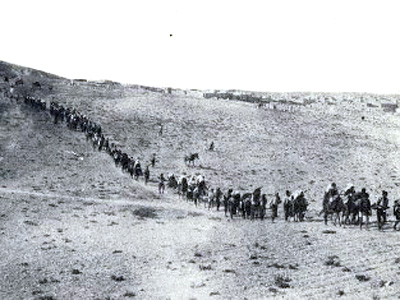
Armenian actions against their Muslim overlords began during the Russian advance into the Eastern Caucasus khanates (principalities) in 1796. These khanates, although nominally under Persian rule, were in fact ruled by local lords (khans). Their populations were mainly Turkish, with large communities of other Muslims and Armenians. When Russian armies invaded Armenian subjects of the khans acted as spies. For example, Armenians delivered the plans of the water supply of Derbend to the Russians, allowing the city to be taken.
Armenian armed units fought alongside the Russians in the take overs of the Muslim khanates. The Armenian archbishop Argutinskii-Dolgorukov in the 1790s preached his desire that the Russians would end Muslim rule over the Armenians through conquest. The archbishop’s wish was fulfilled. In the khanate of Ganjah, for example, Russians and their Georgian auxiliaries slaughtered untold numbers of Muslims upon taking the city of Ganjah, then spread their depredations to the countryside. After the conquest, mosques were confiscated and Muslim religious funds seized. The Muslim population was persecuted. Finally, many of the Muslims of Ganjah fled, to be replaced by Christians. After the conquest of the khanates, the Tsar’s officials encouraged Armenians to immigrate to the new possessions of the Russian Empire and so increase the Christian population. (One of the areas of Armenian immigration was the Khanate of Karabagh, which still features in Armenian-Turkish conflicts today.) However, massive immigration of Armenians was not to begin until the 1820s. The khanates of the Southwestern Caucasus were unlike Circassia and Abkhazia in that their populations were dense and fairly pacific. The Russian policy of forced migration was put to better use in the Khanate of Yerevan.
From the book of Justin McCarthy, Carolyn McCarthy. “Turkrks and armenians” – A Manual on the Armenian Question.










 Inauguration ceremony of President of Azerbaijan Ilham Aliyev was held
Inauguration ceremony of President of Azerbaijan Ilham Aliyev was held Ilham Aliyev wins presidential election with 92.05 percent of votes VIDEO
Ilham Aliyev wins presidential election with 92.05 percent of votes VIDEO President Ilham Aliyev, First Lady Mehriban Aliyeva and family members voted in Khankendi VIDEO
President Ilham Aliyev, First Lady Mehriban Aliyeva and family members voted in Khankendi VIDEO Plenary session of 6th Summit of Conference on Interaction and Confidence Building Measures in Asia gets underway in Astana. President Ilham Aliyev attends the plenary session VIDEO
Plenary session of 6th Summit of Conference on Interaction and Confidence Building Measures in Asia gets underway in Astana. President Ilham Aliyev attends the plenary session VIDEO President Ilham Aliyev was interviewed by Azerbaijani TV channels in Prague VIDEO
President Ilham Aliyev was interviewed by Azerbaijani TV channels in Prague VIDEO














